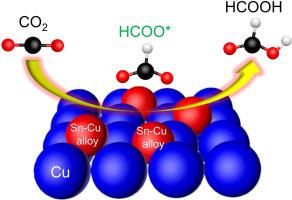Science Bulletin ( IF 18.8 ) Pub Date : 2020-01-23 , DOI: 10.1016/j.scib.2020.01.020 Ke Ye 1 , Ang Cao 2 , Jiaqi Shao 1 , Gang Wang 1 , Rui Si 3 , Na Ta 2 , Jianping Xiao 2 , Guoxiong Wang 2

|
To acquire the synergy effects between Sn and Cu for the jointly high Faradaic efficiency and current density, we develop a novel strategy to design the Sn-Cu alloy catalyst via a decorated co-electrodeposition method for CO2 electroreduction to formate. The Sn-Cu alloy shows high formate Faradaic efficiency of 82.3% ± 2.1% and total C1 products Faradaic efficiency of 90.0% ± 2.7% at −1.14 V vs. reversible hydrogen electrode (RHE). The current density and mass activity of formate reach as high as (79.0 ± 0.4) mA cm−2 and (1490.6 ± 7.5) mA mg−1 at −1.14 V vs. RHE. Theoretical calculations suggest that Sn-Cu alloy can obtain high Faradaic efficiency for CO2 electroreduction by suppressing the competitive hydrogen evolution reaction and that the formate formation follows the path of CO2 → HCOO* → HCOOH. The stepped (2 1 1) surface of Sn-Cu alloy is beneficial towards selective formate production.
中文翻译:

Sn-Cu 合金催化剂的协同效应用于高效 CO2 电还原生成具有高质量活性的甲酸盐
为了获得 Sn 和 Cu 之间的协同效应以实现共同的高法拉第效率和电流密度,我们开发了一种新策略,通过用于 CO 2电还原生成甲酸盐的装饰共电沉积方法设计 Sn-Cu 合金催化剂。与可逆氢电极 (RHE) 相比,Sn-Cu 合金在 -1.14 V 时显示出 82.3% ± 2.1% 的高甲酸盐法拉第效率和 90.0% ± 2.7% 的总 C 1产物法拉第效率。甲酸盐的电流密度和质量活度在 -1.14 V 相对于 RHE 时高达 (79.0 ± 0.4) mA cm -2和 (1490.6 ± 7.5) mA mg -1 。理论计算表明,Sn-Cu合金对CO 2可以获得较高的法拉第效率通过抑制竞争性析氢反应进行电还原,甲酸盐的形成遵循 CO 2 → HCOO* → HCOOH 的路径。Sn-Cu合金的阶梯状(2 1 1)表面有利于选择性甲酸盐的产生。











































 京公网安备 11010802027423号
京公网安备 11010802027423号